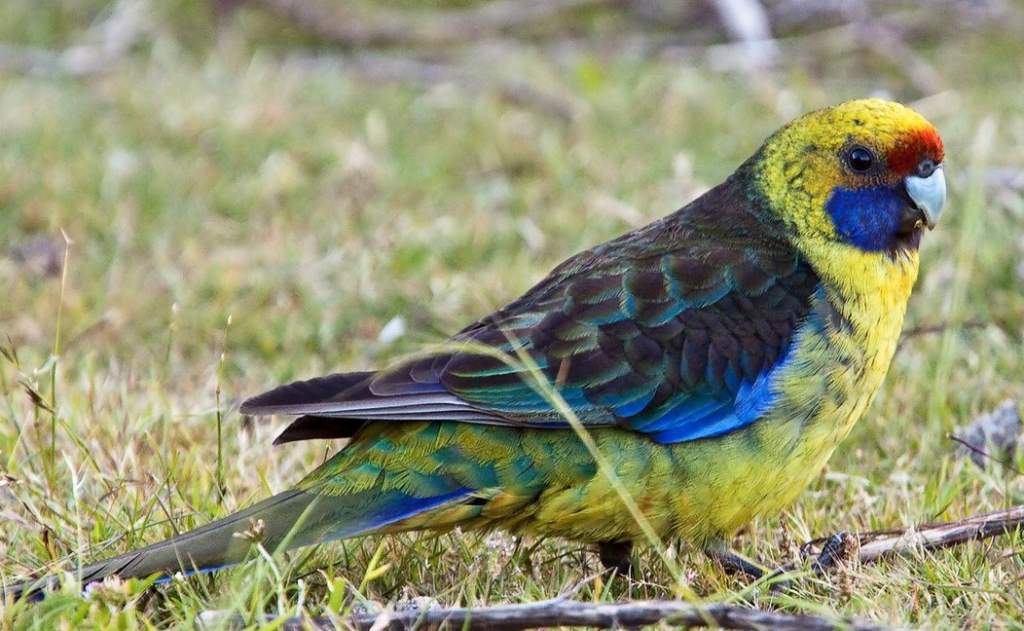Green rosella (Platycercus caledonicus) is a large species that is often regarded as a pest in Tasmania. It is not uncommon to see them quietly eating fruit from orchards. Fruits and seeds of native trees and shrubs are the main foods of the Green Rosella, and some eucalypt blossoms provide nectar as well. Their feeding period usually takes place between early morning and midday. As well as eating insect larvae, the parrot may also eat insects such as psyllids.
They are often seen in parks and vacant areas on the fringes of towns, sometimes in noisy flocks, but when they feed, they are quiet and unobtrusive. They are often seen in small flocks of three or four pairs when dining or ‘socializing’ in trees, even though adults appear to mate for life. Even during the breeding season, this association may continue. The breeding territory might not extend beyond the nest site if it exists, and there is no feeding territory.
A bird displays to its mates in a tree and often to other birds in its social group as well. A male straightens up, drops his wings, fluffs his body feathers, and shakes his tail, bowing slightly and chattering musically. There is usually one brood raised each year by the female, who incubates it. About five weeks after hatching, the young leave the nest but remain with their parents for another month or so before dispersing into flocks.
During the time they spend in flocks, they gain adult plumage and become able to breed. The Green Rosella’s flight is characterized by strong, direct flights interspersed with long glides. The tails of these birds are fanned when they alight. Their habitat consists of coastal and mountain eucalypt forests, woodlands and scrubs, temperate rainforests, and forest edges from sea level to 1500 meters, avoiding open fields.
It is also known as Tasmanian rosella and mountain rosella. Including its long, rounded tail, the Green Rosella measures about 320–360 mm in length. This species is the largest of the Rosella genus. There is no difference between the sexes, but the male usually has a heavier bill and a broader head. There is a lemon-yellow head and neck with a scarlet brow and cobalt cheeks on this creature.
There is a narrow and indistinct dark green edge along the back side of the feathers. Copper-yellow is the color of the rump. The inner flight feathers of the wings are a rich blue wash over dusky black wings. Bright blue is the color of the underside and outer coverts, while jet black is the color of the inner coverts. There are broad pale blue edges on all feathers except the central pair on the tail. A rich yellow underside is sometimes washed with orange-red on the breast, particularly in females. Eyes are mid-brown. Bill is pale gray with slate-grey cere. Feet and claws are dirty or dark slate-grey.
A dull greenish-yellow color covers the upper surface and a dull green-yellow color covers the underside of the immature bird. The brows are scarlet, the cheeks are blue, and the flight feathers are dusky blue with a concealed white bar. With the exception of the central pair of tail feathers, all of the tail feathers have broad, pale blue tips.
Young, downy birds have white-downed plumage and buff bills. A green Rosella call can be divided into four types: a series of high-pitched, ringneck-like notes clinking in alarm, usually given in flight; a high-pitched, usually two- or three-note bell-like call that echoes for a considerable distance and appears to be a contact call; a softer, lower-pitched call of five to ten quickly repeated whistled notes used as a contact call; a rich, musical chatter given by flocks of birds.
Breeding and nesting occur between September and January. A nest of rough wood chips and debris is usually found in tall eucalyptus trees. The Green Rosella lays four or five, sometimes six, round, cream-colored eggs 30 x 24 mm in size. Approximately 20–22 days are needed for incubation by the female.
It is found in Tasmanian eucalypt forests, at all altitudes, and on Bass Strait islands, which are abundant with this species, which can be found in all wooded habitats, particularly eucalypt forests. Maria, Bruny, De Witt, and Maatsuyker Islands are also offshore islands where they can be found. Due to land clearing on King Island and possibly competition with introduced common starlings for nesting sites, it has become rare.
Read More: Western Rosella (Platycercus icterotis).










